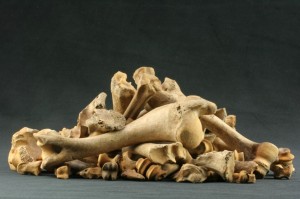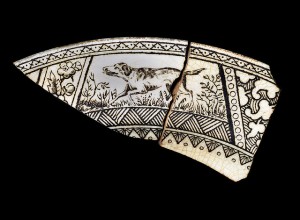Context is very important. Context is especially important to archaeology and the study of artifacts. Without context, the artifacts have no meaning, a piece of glass is just a piece of glass, and a plate is a plate. If we don’t know where an item was found and what it is in relationship to the site and the site’s past then it means nothing.
For instance, a bunch of cow bones is just a pile of animal bones, until we factor in that it was found in the dump site of an 17th century pub and inn, and the cut marks on the bone shows that it was hand sawn and the cut of meat that it was shows the socioeconomic class that the people who ate the cow were in, and therefore reveals the people whom the pub catered to. Any other bones can do the same thing. Different fish are found in different areas, and different people and social classes eat certain kinds of fish. By finding a particular fishes bones in the inn we know that they fed and whom they traded with, as well as at that time, and what was available to them. Bones, as well as many other artifacts, such as plates and ceramic bowls, can be very useful in finding this type of information out, but only if there is context and background.
The different patterns on plates can tell us if they were decorative or used in every day life. The type of style and skill that went into the plates can also tell us how they were used, when they were used, and who used them. The same goes for ceramic bowls, for if only the outside was decorated, that means that it was a larger bowl or vase, with a smaller opening on the top, or that it was meant for other people to look at, while decorations on the inside means that it was small or meant for more personal use. Still, context is very important. If this was found in the inn, then we know what it was used for, and if they were nice plates and bowls, what types of people they housed.
This idea of context can also be applied to where in the site it was found. Many hours are spent labeling the bags where the artifacts have been placed, with detailed locations of where the artifacts were found, at what test pit, with a unit number and other specific location identifiers. Location is very important to context and the meaning of an artifact, for if bones were found in the dumping site of a house, then they would mean a totally different thing then if they were associated with a barn or pub.
In general, artifacts aren’t just pieces of pottery, or a pile of bones, they are items and objects that, because of context, lend themselves to a bigger picture and a better understanding of our world.
-Laila



As you say, fish bones, like those found at the Maryland tavern, can certainly indicate subsistence and trading patterns among different groups. But what if they could prove a large cultural shift? James Barrett, Alison Locker, and Callum Roberts thought fish bones could provide a crucial piece of their study of the transitional period between the Dark Ages and the Middle Ages in what is now the United Kingdom. Around 1000 AD, the archaeological record shows a large increase in fishing, particularly cod and herring, and shows evidence of their trade as far as inland as York and as far north as Scotland. They argue that the rapid growth of the fish trade marks the end of limited ‘Dark Age’ commerce and the beginning a more robust medieval economy. Fish trade created new ties between then-disparate urban centers and provided a critical economic boon to many nascent medieval cities. After all, as the authors point out, the location of the fish market is normally the “oldest urban nucleus” of medieval cities. All this considered, they argue, the presence of fish trade in the archaeological record “clearly represents the beginning of an economic phenomenon– rather than simply the earliest historical documentation of that phenomenon.”
If you’d like to learn more about their research, their article is here: http://www.thefreelibrary.com/'Dark+age+economics'+revisited%3A+the+English+fish+bone+evidence+AD…-a0123120554